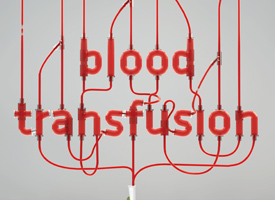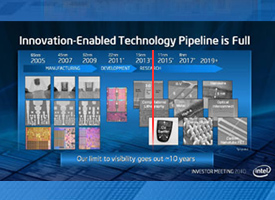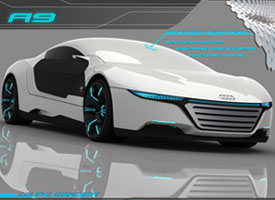 The Online Time Capsule
The Online Time Capsule Magic Leap is bringing the fun and video games to the world you’re already in
Magic Leap is bringing the fun and video games to the world you’re already in
Logically, I know there isn’t a hulking four-armed, twisty-horned blue monster clomping in circles in front of me, but it sure as hell looks like it.
I’m sitting behind a workbench in a white-walled room in Dania Beach, Florida, in the office of a secretive startup called Magic Leap. I’m staring wide-eyed through a pair of lenses attached to what looks like metal scaffolding that towers over my head and contains a bunch of electronics and lenses. It’s an early prototype of the company’s so-called cinematic-reality technology, which makes it possible for me to believe that the muscular beast with the gruff expression and two sets of swinging arms is actually in the room with me, hovering about seven feet in front of my face.
He’s not just visible at a set distance. I’m holding a video-game controller that’s connected to the demo station, and at the press of a button I can make the monster smaller or larger, move him right or left, bring him closer, or push him farther away.
Of course, I bring him as near as possible; I want to see how real he looks up close. Now he’s about 30 inches from my eyeballs and, though I’ve made him pocket-sized, looks about as authentic as a monster could—he seems to have rough skin, muscular limbs, and deep-set beady eyes. I extend my hand to give him a base to walk on, and I swear I feel a tingling in my palm in expectation of his little feet pressing into it. When, a split second later, my brain remembers that this is just an impressively convincing 3-D image displayed in the real space in front of me, all I can do is grin.
Virtual- and augmented-reality technologies used in movies, smartphone apps, and gadgets tend to underdeliver on overhyped promises with images that look crappy. Typically that’s because stereoscopic 3-D, the most commonly used method, is essentially tricking your eyes instead of working with the way you normally see things. It produces a sense of depth by showing each eye a separate image of the same object at a different angle. But since that forces you to look simultaneously at a flat screen in the distance and images that appear to be moving in front of you, it can make you dizzy and lead to headaches and nausea.
To be sure, stereoscopic 3-D has recently started getting better. The best system you can currently buy comes from Oculus VR, which Facebook purchased last spring for $2 billion; the $199 Gear VR, which was built in collaboration with Samsung and is aimed at software developers, lets you slide a Samsung smartphone into a headset to play games and watch videos.
Abovitz says he and his employees are trying to “blow away” their inner 11-year-olds.
But while Oculus wants to transport you to a virtual world for fun and games, Magic Leap wants to bring the fun and games to the world you’re already in. And in order for its fantasy monsters to appear on your desk alongside real pencils, Magic Leap had to come up with an alternative to stereoscopic 3-D—something that doesn’t disrupt the way you normally see things. Essentially, it has developed an itty-bitty projector that shines light into your eyes—light that blends in extremely well with the light you’re receiving from the real world.
As I see crisply rendered images of monsters, robots, and cadaver heads in Magic Leap’s offices, I can envision someday having a video chat with faraway family members who look as if they’re actually sitting in my living room while, on their end, I appear to be sitting in theirs. Or walking around New York City with a virtual tour guide, the sides of buildings overlaid with images that reveal how the structures looked in the past. Or watching movies where the characters appear to be right in front of me, letting me follow them around as the plot unfolds. But no one really knows what Magic Leap might be best for. If the company can make its technology not only cool but comfortable and easy to use, people will surely dream up amazing applications.
That’s no doubt why Google took the lead in an astonishingly large $542 million investment round in Magic Leap last October. Whatever it is cooking up has a good chance of being one of the next big things in computing, and Google would be crazy to risk missing out. The investment looked especially prescient in January, when Microsoft revealed plans to release a sleek-looking headset this year. HoloLens, which lets you interact with holograms, sounds as if it’s very similar to what Magic Leap is working on.
Full article: http://www.technologyreview.com/featuredstory/534971/magic-leap/�
 The Enzyme That Can Convert Any Blood Into Universal Donor Type is fully approved
The Enzyme That Can Convert Any Blood Into Universal Donor Type is fully approved
When you’re rushed into the hospital for a blood transfusion, what happens if they don’t have your blood type? It’s a problem that scientists have been trying to solve for decades, and they might have finally made a breakthrough. By modifying an enzyme to snip off the antigens from types A and B blood, they’ve managed to make it more like the universal donor type O. The study is published in the Journal of the American Chemical Society.
The A and B antigens are sugars that are carried on the surface of red blood cells. It is the combination of these antigens—with blood cells having one, all, or none of these antigens—that give rise to the four principal blood types: A, B, AB, and O. This is what determines which blood you can accept and who you can give blood to. So whilst type O can be given to anyone as the blood cells have neither antigen, all other types can cause life-threatening immune reactions if given to the wrong patient.
The idea of converting blood types has existed since the 1980s, when a team in New York was able to demonstrate that an enzyme extracted from green coffee beans was able to remove B antigens from red blood cells. Clinical trials showed that the blood could be safely transfused to people of a different blood group. However, the enzyme reaction was simply far too inefficient, requiring too large a volume at too high a temperature to convert all the blood cells to make the process practical.
However, scientists from the University of British Columbia have created an enzyme that could potentially solve this problem. It works in exactly the same way, by snipping off the problem antigens, and effectively turning A and B blood into type O. As Steve Withers, one of the researchers explains, “The concept is not new but until now we needed so much of the enzyme to make it work that it was impractical. Now I'm confident that we can take this a whole lot further.”
The team created the enzyme through a process known as "directed evolution." This is a method of protein engineering that is based on natural selection and allows a user to evolve a protein, such as an enzyme, towards a desired goal. Starting with an original enzyme, the scientist inserted mutations into the gene that codes for it. By selecting the mutants that were most efficient in removing the antigens, and repeating the process again and again, the researchers were able to make the enzyme 170 times more effective over just five generations.
“We produced a mutant enzyme that is very efficient at cutting off the sugars in A and B blood, and is much more proficient at removing the subtypes of the A-antigen that the parent enzyme struggles with,” said David Kwan, the lead author of the study and a postdoctoral fellow in the Department of Chemistry.
Their job, however, is not yet done. Whilst the enzyme was able to remove the vast majority of antigens from type A and B blood, they were not able to remove all of them. As the immune system is incredibly sensitive to blood groups—so much so that even small amounts of residual antigen can trigger an immune response—the scientists must first be certain that all antigens are absent.
Source: http://www.iflscience.com/health-and-medicine/scientists-edge-closer-being-able-change-blood-types��������������

 Rainwater Harvesting:The Next Big Thing
Rainwater Harvesting:The Next Big Thing
Landscape contractors will be interested to note that a new report on the role of water in the green building movement notes that the bulk of building projects in the U.S. miss out on one of the most potentially significant water conservation opportunities: rainwater catchment and reuse.
“We’re using fresh domestic drinking water to irrigate grass and replenish cooling towers,” says Rick Reinders, president of Watertronics, manufacturer of SkyHarvester rainwater harvesting systems. “By harvesting rainwater, you’re reusing that water, and it’s not going into the treatment system. That not only saves water but also relieves pressure on sewer and septic systems.”
“Rainwater harvesting systems are becoming increasingly popular among commercial builders and engineers,” says Reinders. “What has been missing is a strong, single-source national supplier to provide integrated design and customized solutions. SkyHarvester offers a single-source solution for commercial rainwater harvesting systems at new or existing building sites.”
Rainwater collection tanks are stored above or below ground and range in size with a typical capacity being 20,000 gallons and maximum capacity around 1 million gallons. According to the report, many rainwater harvesting systems are custom-engineered from various components but a few packaged systems are now available.
“Our systems can help companies reduce potable water needs by up to 80 percent and can even pay for themselves in a few years,” Reinders says. “They can increase commercial property values and may be eligible for tax and other financial incentives from local and other governmental entities.”
More information(source): http://landscapeonline.com/research/article/12862�

 True Blood: First Synthetic Blood Transfusion On A Human
True Blood: First Synthetic Blood Transfusion On A Human
The United Kingdom’s National Health Service has announced it will attempt what is believed to be the first synthetic blood transfusion on human volunteers in 2017. If successful, such a medical breakthrough could help to create specialized donations for patients suffering from blood conditions and may even eventually give health services an unlimited supply of red blood cells for emergency transfusions.
Volunteers will be given only a few teaspoons of the synthetic blood to test for any adverse reactions. So far, lab tests have shown that the synthetic red blood cells are “comparable if not identical to the cells from a donor,” said Dr. Nick Watkins, assistant director of research and development at NHS Blood and Transplant, The Independent reported. The trials will first consist of transfusions made from the stem cells of adult donors. If this blood is received well, the researchers will attempt to give volunteers a transfusion of artificial blood made from stem cells extracted from umbilical cord blood donated by consenting mothers. These tiny transfusions will also give scientists time to study how long the synthetic blood is able to survive inside the human body.
What Is Synthetic Blood?
Synthetic blood is the holy grail of the medical community. For years now, scientists around the world have been investigating how to manufacture red blood cells as both an alternative to donated blood and to treat patients with specific blood-related conditions. This artificial blood was created by scientists involved with the NHS and is part of an ambitious five-year research and development plan meant to advance the practice of blood transfusion, organ transplantation, and regenerative medicine.
The blood is created by isolating stem cells, either extracted from umbilical cords or from the blood of adult donors, Newsmax reported. The stem cells are then cultured in nutrients that stimulate them to develop into red blood cells. Blood is composed of three components: red cells, plasma, and platelets. Red blood cells carry oxygen from the lungs to the rest of the body. Although all components are in need of donations, according to The Red Cross, red cell storage is often in short supply. Therefore, the need for an unlimited amount of red blood cells is most pressing.
The intention is not to replace blood donation but to provide specialist treatment for specific patient groups, Watkins explained. The immediate goal of the manufacturing of synthetic blood is to provide alternatives for individuals with blood conditions, such as sickle cell anemia and thalassemia, who need regular transfusions. Watkins hopes that scientists will soon be able to provide appropriate blood products specific to each patient's need — a sort of customized blood transfusion.
More long-reaching plans of this NHS initiative include the creation of an unlimited supply of blood for blood banks. The current availability of donated blood does not match its need. According to the Blood Centers of the Pacific, only 37 percent of the American population is actually eligible to donate blood, and of this group, an estimated less than 10 percent actually do so regularly. Factors such as weight, past drug use, and having visited certain areas of the globe prevent many from donating their blood. The NHS hopes that synthetic blood will help to address the deficit availability of blood donations and also to keep blood's price low.
Source: http://www.medicaldaily.com/���

 Spider-Man Returns to Marvel
Spider-Man Returns to Marvel
In a superhero reunion of sorts, Sony Pictures Entertainment has announced a new deal with Marvel Studios that brings new Spider-Man movies into the Marvel cinematic universe.
The next Spider-Man film will hit theaters on July 28, 2017.
Sony has owned the feature rights to Spider-Man since 1999, when Marvel sold the comic book hero for $7 million.
Sony and Marvel will cast a new Spider-Man after Andrew Garfield starred in the last two superhero films, “The Amazing Spider-Man” and “The Amazing Spider-Man 2.” Tobey Maguire previously portrayed Peter Parker in three films for Sony.
Marvel’s Kevin Feige will produce the rebooted Spidey with Amy Pascal, who recently stepped down as co-chairman of Sony in a new producer deal. She oversaw the $4 billion Spider-Man franchise for over 13 years at the studio.
According to Monday’s announcement, Sony will continue to distribute, finance, own and have final creative control of the Spider-Man pics.
They’ll work with Marvel,
Source: http://www.imdb.com/news/ni58274688?ref_=hm_nw_tp1
Official page of the movie: http://www.imdb.com/title/tt2250912/?ref_=nv_sr_6

 Moore's law is cracked: Intel's next chips transition come in 2.5 years. 10nm Cannon Lake is scheduled for late 2017
Moore's law is cracked: Intel's next chips transition come in 2.5 years. 10nm Cannon Lake is scheduled for late 2017
THE THEORY OF MOORE'S LAW might be showing cracks after Intel CEO Brian Krzanich announced that the firm's shift from one transistor size to another is stretching from two to 2.5 years.
Moore's Law is the prediction made by Intel co-founder Gordon Moore that computing power would double every two years.
The law turned 50 earlier this year, and Intel said that the best is yet to come, and that the law will become more relevant in the next two decades as everyday objects become smaller, smarter and connected.
Intel has adhered to this in the past, using a 'tick-tock' strategy when launching new processors. The 'tick' refers to a shrinking of the manufacturing process, while the 'tock' is an improvement of the design and architecture at the same size.
However, Krzanich questioned this during Intel's earnings call on Wednesday, saying that manufacturing processes haven't advanced at the same rate as in the past.
"The [tick-tock] strategy created better products for our customers and a competitive advantage for Intel," said Krazanich.
"It also disproved the death of Moore's Law predictions many times over. The last two technology transitions have signalled that our cadence today is closer to 2.5 years than two."
He added that to address this, Intel plans to introduce a third 14nm product, codenamed Kabylake, in the second half of 2016 built on the foundations of the Skylake micro-architecture but with performance enhancements.
The firm will then launch its first 10nm product, codenamed Cannonlake, in the second half of 2017.
"We expect that this addition to the roadmap will deliver new features and improved performance and pave the way for a smooth transition to 10nm," he added.
However, Krzanich denied that this slip means that Intel is losing grip as a leading chip manufacturer.
"We believe, even with this in 2017, our lead in Moore's Law will not change dramatically. We believe we'll continue to lead with roughly the same position that we have today," he said.
"We base that on what really counts when I talk about 2017. That's not samples, that's not small volume. That's converting over the Cannonlake and producing a large percentage of our CPUs in volume in the second half of 2017.
"So there's a bit of definition. So at the second half of 2017, we're talking about millions of units and large volumes."
Krzanich explained that there are a number of reasons why the transitions in Intel's chip technology are taking longer.
The lithography continues to get more difficult as the firm tries to scale, and the number of multi-pattern steps needed increases, but this is the longest period of time without a lithography node change.
"So we're assuming 10nm does not have EUV [extreme ultraviolet lithography] for our technology," he said. "That's combined with the other material science changes you do with the new technology."
The admission of a change in cadence was the most interesting news to come out of the earnings call, but wasn't the only thing Intel had to talk about.
The company posted Q2 earnings of 55c per share on revenue of $13.2bn, operating income of $2.9bn and net income of $2.7bn.
This represented a 3.2 percent drop in Q2 profit on revenues that fell 4.6 percent, but was better than analysts had expected. Wall Street had predicted 50c a share on $13.04bn.
Intel blamed weaker than expected growth in the PC market for the decline, but still reported strong data centre and Internet of Things business, which helped offset weak demand for PCs that use Intel chips.
The firm reported data centre group revenue of $3.9bn, five percent higher sequentially and up 10 percent from the same period a year ago.
"Q2 results demonstrate the transformation of our business as growth in data centre, memory and IoT accounted for more than 70 percent of our operating profit and helped offset a challenging PC market," said Krzanich.
"We continue to be confident in our growth strategy and are focused on innovation and execution.
"We expect that the launches of Skylake, Microsoft's Windows 10 and new OEM systems will bring excitement to client computing in the second half of 2015."
Source: http://www.theinquirer.net/���

 The birth of AUDI's future kind - A9
The birth of AUDI's future kind - A9
Hand-built over seven weeks this fall, the glimmering full-size coupe is a rolling exhibition of Audi's future. The design elements from the car's interior and exterior will be incorporated into the next generation of Audi's large cars, starting with the new Audi A8 sedan due for sale in 2017.
The midsize A6 and A7 will follow shortly after that. Audi is also expected to build a coupe very similar to this Prologue. Based on the A8, the car probably will be the first car to bear the A9 name in Audi's history, and will take Mercedes-Benz's S-Class Coupe head-on.
This is the first time the Audi prototype cruised down any city street. It's the first time Audi's new design chief, Marc Lichte, has seen the car on a real road. He's in one of the two SUVs ahead of us in the motorcade, in front of another police unit.
In the midst of scrambling to reinvent the face of Audi, Lichte was also tasked with creating the Prologue concept. While the company hasn't officially confirmed it will build an A9 that the Prologue foreshadows, any mention of it around Audi execs is met with a wink and a nod. Bet on this car reaching production.
This concept car, according to the company, incorporates 80% to 90% of the production cars' design cues, inside and out.
Key among the exterior cues is a massive flat grille that spans nearly the entire width of the car's nose. It's highlighted by six horizontal chrome bars and Audi's four-rings logo prominently displayed in the middle. Thin trapezoidal headlights squint out from either side of it.
The coupe's roofline descends slowly toward the rear of the car, leaving almost no flat trunk lid. This makes Prologue's silhouette imposing and dramatic, and looking a smidge heavy.
At the back, LED taillights are horizontally oriented, including a thin strip of lights running the entire width of the back end. The taillights also have a sculpted three-dimensionality to them that's hard to show in pictures.
The car's fenders swell outward to cover each of the wheels, a deliberate move by Lichte to highlight Audi's Quattro all-wheel-drive system in the same way a rear-wheel-drive Mercedes or BMW is often denoted by a long hood.
The overall look of the Prologue is less revolutionary and more of a healthy evolution. True to its production intent, the coupe looks at home on L.A.'s streets rather than looking like a Jetsons science experiment.
The Jetsons stuff is inside the car.
Using the same horizontally oriented theme as on the exterior, several touch-sensitive screens stretch across the dashboard for both the driver and passenger.
Audi also worked with Samsung to develop a cutting-edge OLED flexible glass screen that curves out of the center console just ahead of the shifter. Flexible display screens like this are at the infancy of their development, though manufacturers like LG and Samsung hope to have production screens on the market around the same time as Audi's next A8 in 2017. They'll be expensive.
The driver's instrument panel on the Prologue is a 3-D digital screen, an elaborate evolution of the wide-screen display Audi recently introduced on its 2016 TT compact sports car. And although Audi is aware that these prototype elements inside the Prologue may seem farfetched, the company says it's determined to be out front on in-car electronics.
The rarity of such flexible glass screens is one of the reasons the Prologue cost Audi millions to build. (The automaker wouldn't reveal the specific figure.) Yet the production car would cost a fraction of that, with the A9 coupe ringing in around the $100,000 to $120,000 mark once Audi confirms it and sells it.
The concept is also pricey thanks to the carbon fiber body panels, the aluminum trim inside and out, and the wood and leather throughout the interior. It's like a couture dress: a one-off piece made, finished and assembled by hand without the economies of scale to drive the price down.
It took a team of 20 people seven weeks working around the clock to build, Audi said. The chassis underneath is a shortened version of what's on the next-generation A8. To power the thing, Audi grabbed a 4.0-liter twin-turbocharged V-8 out of its RS7 and kicked power up a notch. It now cranks out 605 horsepower and 553 pound-feet of torque.
Before we're allowed to drive it, Audi's minders have us don a disposable plastic painter's suit and booties, so as to keep the creamy white leather in perfect condition. True to its concept form, there are no door handles on this coupe; wave your hand over the door sill and it pops open automatically.
A push of the aluminum starter button by the shifter fires up the massive engine in front of us. We tap the shift lever — also touch-sensitive — to put the car in gear. Our minder gives a wave to the cops, who pull out of the parking lot with a blip of their lights and siren, and our mini future-parade is on its way.
The drive is more a low-speed demonstration than an outright test. No one wants a crashed prototype worth millions on his resume. And the massive amount of heat generated by the bleeding-edge electronics causes the engine's computers to retard full acceleration anyway.
But despite its kit-car status, the Prologue concept drives like the sultry coupe that it hopes to be. The suspension is cushy, the steering is direct, and the power — when it's available — is immense. The car's mass and proportions are perfect for the boulevard cruising that our 30-minute drive takes us on, weaving through and around Beverly Hills.
As our escorts slow to a crawl waiting for an intersection to clear up, two men who look like potential A9 owners notice the car and walk up to it, clearly trying to figure out what they're seeing. One whips out his iPhone to snap a picture of the interior.
"What kind of Audi is this?" his friend asks. Our chaperone smiles as the motorcade starts moving again, and says cryptically out the window, "The future kind."
Source: http://www.latimes.com/business/autos/la-fi-hy-audi-a9-concept-20141129-story.html#page=1������

 Movie Prediction: The "Alien" will spawn the new eggs in the Cinemas on June 2017
Movie Prediction: The "Alien" will spawn the new eggs in the Cinemas on June 2017
20th Century Fox has closed a deal with director Neill Blomkamp to develop a new “Alien” movie, sources confirm.
The untitled sci-fi project is separate from “Prometheus 2,” which Fox is still making with Ridley Scott.
Blomkamp, who directed “District 9” and the upcoming Sony feature “Chappie,” had been teasing the project in recent months but said the extra-terrestrial reboot was likely abandoned. It was supposed to star “Alien” veteran Sigourney Weaver.
But on Wednesday Blomkamp confirmed the tentpole was back on track at Fox.
“So I think this is officially my next film,” he confirmed on Instagram.
It’s unclear whether Weaver is still attached to the movie [MY PREDICTION: Sigourney Weaver will be in a supporting role].
According to insiders, the new “Alien” takes place years after the “Prometheus” sequel. Scott is producing both films through his production company Scott Free. [MY PREDICTION: They Will Show Xenomorph X120 before they mutate to species (121) with retractable inner mouth]
“Prometheus,” also distributed by Fox, was “loosely based” on the “Alien” franchise and earned over $400 million worldwide. But the 3D movie opened to mixed reviews, and Fox hopes Blomkamp, who last directed “Elysium,” can take the franchise to the next level.
Source: http://variety.com/2015/film/news/new-alien-movie-confirmed-at-fox-with-director-neill-blomkamp-1201436551/���������

 The Ocumetics Bionic Lens Revolutionize the way we see the World
The Ocumetics Bionic Lens Revolutionize the way we see the World
A new bionic eye lens currently in development would give humans 3x 20/20 vision, at any age.
The lens, named the Ocumetics Bionic Lens, was developed by Dr. Garth Webb, an optometrist in British Columbia who was looking for a way to optimize eyesight regardless of a person’s health or age.
With this remarkable lens, patients would have perfect vision, ending the need for driving glasses, progressive lenses, and contacts, all of which are set to become a dim memory as the eye-care industry is transformed, CBC reports.
Even better is the fact that people who get the lens surgically inserted will never get cataracts, because the lens replaces that of their natural eye, which inevitably decays over time.
Webb says that anyone over the age of 25 is the best candidate, because that is when the eye is fully developed.
“This is vision enhancement that the world has never seen before,” he says, “If you can just barely see the clock at 10 feet, when you get the Bionic Lens you can see the clock at 30 feet away.“
The lens, which would be custom-made, is folded like a taco in a saline-filled syringe and placed in the eye, where it unravels itself within 10 seconds.
Quick & Painless Surgery
Webb says that the surgery can be done within 8 minutes and immediately corrects a patient’s vision.
The project has been in the works for the last eight years, Webb told CBC, costing about $3 million in research and development fees, along with the acquisition of international patents and the securing of a biomedical manufacturing facility in Delta, B.C.
His mission is fueled by the “obsession” he’s had to free himself and others from corrective lenses since he was in Grade 2, when he was saddled with glasses.
“My heroes were cowboys, and cowboys just did not wear glasses,” Webb says.
Webb’s efforts were recently recognized after he presented the lens to 14 top ophthalmologists in San Diego during a gathering of the American Society of Cataract and Refractive Surgery.
Surgeons from all around the world were intrigued by his “clever” design, Webb says.
“I think this device is going to bring us closer to the holy grail of excellent vision at all ranges — distant, intermediate and near,” said Dr. Vincent DeLuise, an ophthalmologist who teaches at both Yale University and Weill Cornell Medical College in New York.
Trials & Tribulations
Pending clinical trials on animals and then blind human eyes, the Bionic Lens could be available in Canada and elsewhere in about two years, depending on regulatory processes in various countries, Webb says.
Webb is hopeful that his lens will do away with the need for laser eye surgery, a procedure that still isn’t as efficient as it could be.
“Perfect eyesight should be a human right,” he says.
Source: http://www.collective-evolution.com������

 Mobile phone charges are finally abolished by European Union
Mobile phone charges are finally abolished by European Union
Members of the European parliament have voted through new rules that will scrap mobile roaming charges and stop holidaymakers returning home to the nightmare of a massive phone bill racked up on their travels.
The vote sees the deal reached between European authorities in June to scrap increased costs for calls, text and data while roaming with the EU, passed into law.
UK mobile phone users who travel within Europe will only have to pay the same prices as they would at home, curbing the cost of continued mobile connectivity while abroad.
Former vice-president of the European Commission and rapporteur for the Trade in Services Agreement, Viviane Reding said: “After 10 years of tireless fight, roaming is over. A victory for consumers and a stepping stone towards a truly European digital single market.”
Liberal Democrat MEP Catherine Bearder said: “The end of rip-off roaming fees is a massive win for British consumers. Driving down costs and making it easier to travel is what being in the EU is all about.
“This shows what we can achieve when Britain plays a leading role in Europe.”
The news was welcomed by campaigners, though some were cautious over some clauses that might limit the agreement’s utility for all.
Monique Goyens, director general of the European Consumer Organisation said: “Another cost cut for mobile use abroad by April 2016 is good news, but is still only a half-baked solution.
“Allowing companies to limit roaming rights for frequent travellers, for example, is certainly not the promised end of roaming in Europe. A real zero-roaming Europe hinges on a major telecom market reform, which is a mammoth task to achieve in just 13 months.”
More than two years in the making
The vote followed more than two years of negotiations and U-turns as the European parliament butted heads with EU member states concerned about the financial impact on their national telecoms groups.
The anti-roaming plans had been scheduled for the end of 2015, but were blocked in March by ministers of national governments through the European council.
The roaming plans were twinned with a vote over amendment to telecoms regulation that would have reinforced European net neutrality, the principle that internet service providers should not give preferential treatment to certain websites and services. The amendments were rejected, leading to criticism by net neutrality campaigners.
The commission is saying the new amendments to the telecoms market will be an end to “huge telephone bills ruining your holiday budget”.
This year, phone operators can still charge travellers to European member states up to 19 cents (14p) a minute for outgoing calls, five cents for incoming calls, six cents per text message, and 20 cents per megabyte of data downloaded, on top of their normal tariff.
In April next year those costs will be reduced to five cents per minute, two cents per SMS and five cents per MB. Roaming charges will not be completely removed until June 2017 and will require reform of the roaming wholesale market on which national phone operators across Europe trade services between each other.
It is this trade that allows UK mobile phone users to make calls, send texts and access data using European networks while in countries such as Germany, Spain or France.
Some operators ahead of the pack
Some UK mobile operators have come out ahead of the roaming changes, others have stuck steadfastly to increased charges that can see bills of hundreds of pounds for holidaymaker usage that would not seem out of the ordinary in the UK.
Some operators, including Vodafone UK, added daily charges to user bills for use of their allowance in European countries. Others, including Hong Kong conglomerate Hutchison Whampoa’s Three UK mobile, removed roaming charges for those travelling to a selection of European countries, mirroring the end goal for the newly passed legislation.
Kester Mann, mobile operators analyst with CCS Insight, said: “A number of providers have opted to offer inclusive roaming in many tariffs. This is a smart and differentiating move given that has resonated well with customers – Three’s Feel at Home service has saved customers £1.3bn in roaming charges and has been used by over 2 million customers.”
Ernest Doku from Uswitch said: “Bill shock from holidaying in the EU affects more than 9 million UK mobile users a year according to our research.”
One-fifth of UK mobile users travelling to the EU in the last year have faced higher than usual bills for usage, collectively amounting to £573m, according to data from Uswitch. The average charge added to bills was £61 on top of a user’s standard contract charge, while 17% faced bills of £100 or more.
Not universal approval
The abolishment of roaming charges was not met with universal approval. In the days before the vote Roger Helmer MEP tabled an amendment to reject the agreement on behalf of Ukip.
Helmer said: “Lower prices for jet-setters will mean higher domestic prices. The EU plan is good for MEPs, bad for voters.”
The next step for regulators is a reform of the roaming wholesale market, which has potential to further delay the process of roaming charge removal beyond June 2017, should talks drag.
Once agreements are in place, it could take the European mobile phone operator market one step closer to being free of its current geographic restrictions.
Mark Windle, head of marketing for telecoms software provider OpenCloud said: “Most mobile network operators are limited to a market defined by their own radio-access network – services are defined by, and delivered from, individual service-siloes in each country – but service provision is capable of being pan-European, if not global.
“The change in roaming charges may flatten the EU for travellers, the creation of a single communications market is not yet in place. But it is coming.”
Source: http://www.theguardian.com/technology/�